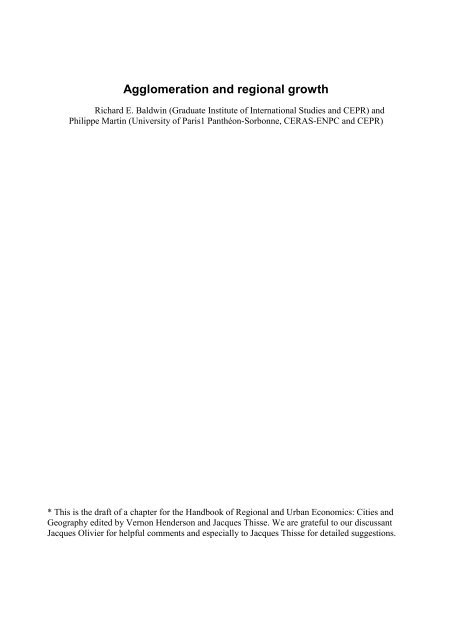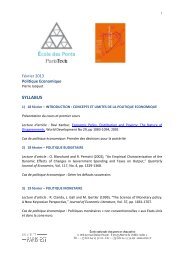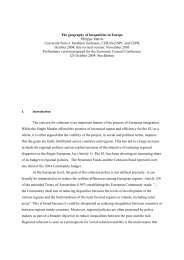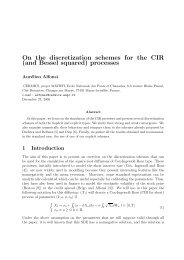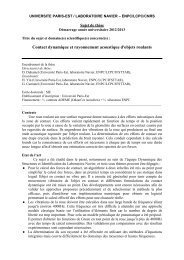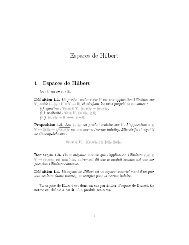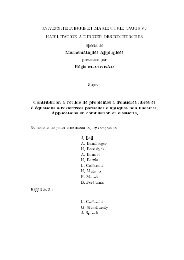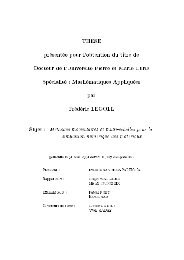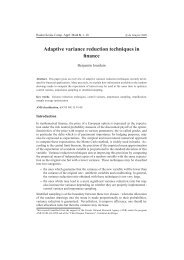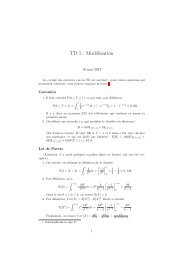Agglomeration and regional growth - ENPC
Agglomeration and regional growth - ENPC
Agglomeration and regional growth - ENPC
You also want an ePaper? Increase the reach of your titles
YUMPU automatically turns print PDFs into web optimized ePapers that Google loves.
1. Introduction: why should we care about <strong>growth</strong> <strong>and</strong> geography?2. The basic framework of <strong>growth</strong> <strong>and</strong> agglomeration3. The case without localized spillovers: <strong>growth</strong> matters for geography3.1. The <strong>growth</strong> equilibrium3.1.1. Endogenous <strong>growth</strong> <strong>and</strong> the optimal savings/investment relation3.1.2. The role of capital mobility3.2. Perfect capital mobility: the location equilibrium3.2.1. Stability of the location equilibrium3.2.2 Does capital flow from the rich to the poor?3.3. No capital mobility: “new <strong>growth</strong>” <strong>and</strong> “new geography”3.3.1. Stability of the symmetric equilibrium3.3.2 The core-periphery equilibrium3.4. Concluding remarks4. The case with localized spillovers: geography matters for <strong>growth</strong> (<strong>and</strong> vice versa)4.1. Necessary extensions of the basic model4.2. The case of perfect knowledge capital mobility4.2.1 Spatial equity <strong>and</strong> efficiency4.2.2 Welfare implications4.3. The case without capital mobility: the possibility of a <strong>growth</strong> take-off <strong>and</strong>agglomeration4.3.1 The long-run equilibria <strong>and</strong> their stability4.3.2 Possibility of catastrophic agglomeration4.3.3 Geography affects <strong>growth</strong>4.3.4 Can the Periphery gain from agglomeration?4.4. The geography of goods <strong>and</strong> ideas: stabilizing <strong>and</strong> destabilizing integration4.4.1 Globalization <strong>and</strong> the newly industrialized countries4.4.2 The learning-linked circular causality5. Other contributions6. Concluding remarks2
1. INTRODUCTIONSpatial agglomeration of economic activities on the one h<strong>and</strong> <strong>and</strong> economic <strong>growth</strong> on theother h<strong>and</strong> are processes difficult to separate. Indeed, the emergence <strong>and</strong> dominance of spatialconcentration of economic activities is one of the facts that Kuznets associated with moderneconomic <strong>growth</strong>. This strong positive correlation between <strong>growth</strong> <strong>and</strong> geographic agglomerationof economic activities has been documented by economic historians (Hohenberg <strong>and</strong> Lees, 1985for example), in particular in relation to the industrial revolution in Europe during the nineteenthcentury. In this case, as the <strong>growth</strong> rate in Europe as a whole sharply increased, agglomerationmaterialized itself in an increase of the urbanization rate but also in the formation of industrialclusters in the core of Europe that have been by <strong>and</strong> large sustained until now. The role of citiesin economic <strong>growth</strong> <strong>and</strong> technological progress has been emphasized by urban economists(Henderson, 1988, Fujita <strong>and</strong> Thisse, 2002), development economists (Williamson, 1988) as wellas by economists of <strong>growth</strong> (Lucas, 1988). At the other h<strong>and</strong> of the spectrum, as emphasized byBaldwin, Martin <strong>and</strong> Ottaviano (2001), the <strong>growth</strong> takeoff of Europe took place around the sametime (end of eighteenth century) as the sharp divergence between what is now called the North<strong>and</strong> the South: <strong>growth</strong> sharply accelerated (for the first time in human economic history) at thesame time as a dramatic <strong>and</strong> sudden process of agglomeration took place at the world level.Hence, as put by Fujita <strong>and</strong> Thisse (2002), “agglomeration can be thought as the territorialcounterpart of economic <strong>growth</strong>.”Less dramatically <strong>and</strong> closer to us, Quah’s results (1996) suggest also a positive relationbetween <strong>growth</strong> <strong>and</strong> agglomeration. He finds that among the Cohesion group of countries(Greece, Spain, Portugal <strong>and</strong> Irel<strong>and</strong>, though there are no Irish <strong>regional</strong> data), the two countriesthat have achieved a high rate of <strong>growth</strong> <strong>and</strong> converged in per capita income terms towards therest of Europe (Spain <strong>and</strong> Portugal) have also experienced the most marked <strong>regional</strong> divergence,This is consistent with the results of De la Fuente <strong>and</strong> Vives (1995), for instance, building on thework of Esteban (1994) who suggest that countries have converged in Europe but that thisprocess of convergence between countries took place at the same time as regions inside countrieseither failed to converge or even diverged. There are however few direct empirical tests of therelation between agglomeration <strong>and</strong> <strong>growth</strong>. Ciccone (2002) analyses the effects of employmentdensity on average labor productivity for 5 European countries at the Nuts 3 <strong>regional</strong> level. Hefinds that an increase in agglomeration has a positive effect on the <strong>growth</strong> of regions. An indirecttest of the relationship is performed in the literature on localized technology spillovers. Thepresence of localized spillovers has been well documented in the empirical literature. Studies byJacobs (1969) <strong>and</strong> more recently by Jaffe et al. (1993), Coe <strong>and</strong> Helpman (1995), Coe et al.(1997), Ciccone <strong>and</strong> Hall (1996) provide strong evidence that technology spillovers are neitherglobal nor entirely localized. The diffusion of knowledge across regions <strong>and</strong> countries does existbut diminishes strongly with physical distance which confirms the role that social interactionsbetween individuals, dependent on spatial proximity, have in such diffusion. A recent study byKeller (2002) shows that even though technology spillovers have become more global with time,“ technology is to a substantial degree local, not global, as the benefits from spillovers aredeclining with distance.” The fact that technology spillovers are localized should in theory leadto a positive link between <strong>growth</strong> <strong>and</strong> spatial agglomeration of economic activities as being“close” to innovation clusters has a positive effect on productivity. Hence, these empirical resultspoint to the interest of studying <strong>growth</strong> <strong>and</strong> the spatial distribution of economic activities in anintegrated framework. From a theoretical point of view, the interest should also be clear. There is3
a strong similarity between models of endogenous <strong>growth</strong> <strong>and</strong> models of the “new economicgeography” (NEG). They ask questions that are related: one of the objectives of the first field isto analyze how new economic activities emerge through technological innovation; the secondfield analyzes how these economic activities choose to locate <strong>and</strong> why they are so spatiallyconcentrated. Hence, the process of creation of new firms/economic activities <strong>and</strong> the process oflocation should be thought as joint processes. From a methodological point of view, the twofields are quite close as they both assume (in some versions) similar industrial structures namely,models of monopolistic competition which reflects the role of economies of scale in both fields.In this chapter, we will attempt to clarify some of the theoretical links between <strong>growth</strong><strong>and</strong> agglomeration. Growth, in the form of innovation, can be at the origin of catastrophic spatialagglomeration in a cumulative process à la Myrdal. One of the surprising features of theKrugman (1991) model, was that the introduction of partial labor mobility in a st<strong>and</strong>ard “newtrade model” with trade costs could lead to catastrophic agglomeration. The <strong>growth</strong> analog to thisresult is that the introduction of endogenous <strong>growth</strong> in the same type of “new trade model” canlead to the same result. A difference with the labour mobility version is that the results are easierto derive from the analytical point of view in the endogenous <strong>growth</strong> version. In addition,<strong>growth</strong>alters the process of location even without catastrophe. In particular, <strong>and</strong> contrary to thefundamentally static models of the NEG, spatial concentration of economic activities may beconsistent with a process of delocation of firms towards poor regions. In common with the staticmodels (see the chapter by Ottaviano <strong>and</strong> Thisse in this volume), the Home Market Effect playshere a crucial role to explain agglomeration.The relation between <strong>growth</strong> <strong>and</strong> agglomeration depends crucially on capital mobility.Without capital mobility between regions, the incentive for capital accumulation <strong>and</strong> therefore<strong>growth</strong> itself is at the heart of the possibility of spatial agglomeration with catastrophe. In theabsence of capital mobility, some results are in fact familiar to the NEG (Fujita, Krugman <strong>and</strong>Venables, 1999): a gradual lowering of trade costs between two identical regions first has noeffect on economic geography but at some critical level induce catastrophic agglomeration. In themodel presented in this chapter, in the absence of migration, “catastrophic” agglomerationmeans that agents in the south have no more private incentive to accumulate capital <strong>and</strong>innovate. The circular causality which gives rise to the possibility of a core-periphery structure isdepicted below <strong>and</strong> as usual in economic geography models is characterized by both production<strong>and</strong> dem<strong>and</strong> shifting which reinforce each other. The production shifting takes the form of capitalaccumulation in one region (<strong>and</strong> de-accumulation in the other) <strong>and</strong> the dem<strong>and</strong> shifting takes theform of increased permanent income due to investment in one region (<strong>and</strong> a decrease inpermanent income in the other region).4
To present the basic elements of this literature, we organize the discussion with the helpof a workhorse model. As Baldwin et al (2003) show, introducing capital into a geography modelis relatively simple. The simplest way is accomplished by the ‘footloose capital’ model (FCmodel) due to Martin <strong>and</strong> Rogers (1995). The FC model, however, takes the capital stock asgiven. Getting to a <strong>growth</strong> model requires us to add in a capital-producing sector.Specifically we denote capital by K <strong>and</strong> labor by L. The capital-producing sector isreferred to as the sector I (for innovation <strong>and</strong> investment, see below) <strong>and</strong> this comes on top of thetwo usual sectors, manufactures M <strong>and</strong> traditional-goods T. The regions (two of them) aresymmetric in terms of preferences, technology <strong>and</strong> trade costs. The usual Dixit-Stiglitz M-sector(manufactures) consists of differentiated goods. Another difference is that the fixed cost is interms of K. Each variety requires one unit of capital which can be interpreted as an idea, a newtechnology, a patent, machinery, etc.. Production also entails a variable cost (a M units of labor perunit of output). Its cost function, therefore, is π +w a M x i , where π is K's rental rate, w is the wagerate, <strong>and</strong> x i is total output of a typical firm. Traditional goods, which are assumed to behomogenous, are produced by the T-sector under conditions of perfect competition <strong>and</strong> constantreturns. By choice of units, one unit of T is made with one unit of L. The structure of the basic<strong>growth</strong> <strong>and</strong> agglomeration model is in figure 2.Regional labor stocks are fixed <strong>and</strong> immobile, so that we eliminate one possible source ofagglomeration. Each region's K is produced by its I-sector. I is a mnemonic for innovation wheninterpreting K as knowledge capital, for instruction when interpreting K as human capital, <strong>and</strong> forinvestment-goods when interpreting K as physical capital. One possible interpretation of thedifference between the situation of capital mobility <strong>and</strong> one of capital immobility is that in thefirst case K is physical capital (mobility then means the delocation of plants) or as knowledgecapital that is marketable <strong>and</strong> tradable through patents. The second case, capital immobility,would be more consistent with the interpretation of human capital. In this case, labor immobilityimplies capital immobility. The I-sector produces one unit of K with a I units of L, so that themarginal cost of the I sector, F, is w a I . Note that this unit of capital in equilibrium is also thefixed cost F of the manufacturing sector. As one unit of capital is required to start a new variety,the number of varieties <strong>and</strong> of firms at the world level is simply the capital stock at the world*level: K W = K + K . We note n <strong>and</strong> n* the number of firms located in north <strong>and</strong> south*respectively. As one unit of capital is required per firm we also know that: K W = n + n .However, depending on the assumption we make on capital mobility, the stock of capitalproduced <strong>and</strong> owned by one region may or may not be equal to the number of firms producing inthat region. In the case of capital mobility, the capital may be produced in one region but the firmthat uses this capital unit may be operating in another region. Hence, the number of firms locatedin one region is, in the case of capital mobility, different from the stock of capital owned by thisregion.6
L, numeraire,w=1T sector (traditional)- Walrasian (CRS& Perf.Comp.)- unit labor costM-sector (Manufactures)- Dixit-Stiglitz monopolistic competition- increasing returns: fixed cost, 1 unitof K- variable cost = a M units of LNo tradecosts ?p T =p T =w=w*=1Icebergtrade costsNorth&<strong>and</strong>SouthmarketsI-sector (Innovation, Investment…) Trade in capital, 2- perfect competitioncases:-intertemporal spillovers (2 cases: -perfect capital mobilityglobal or localized)- no capital mobility- variable cost for one unit of K = a IFigure 2: The basic structure of the <strong>growth</strong> <strong>and</strong> agglomeration modelTo individual I-firms, the innovation cost a I is a parameter. However, following Romer(1990) <strong>and</strong> Grossman <strong>and</strong> Helpman (1991), a sector-wide learning curve is assumed. That is, themarginal cost of producing new capital declines (i.e., a I falls) as the sector's cumulative outputrises. Many justifications of this intertemporal externality, classic in the endogenous <strong>growth</strong>literature, are possible. Romer (1990), for instance, rationalizes it by referring to the non-rivalnature of knowledge. We can summarize these st<strong>and</strong>ard assumptions of this literature by thefollowing:LK=aW W; F = wa ; a = 1/ K ; K = K KII I+Iwhere K <strong>and</strong> K* are the northern <strong>and</strong> southern cumulative I-sector production levels. Note thatspillovers are global: the North learns as much from an innovation made in the South than in theNorth. Below, we introduce localized technological spillovers. Following Romer (1990) <strong>and</strong>Grossman <strong>and</strong> Helpman (1991), depreciation of knowledge capital is ignored. 2 Finally, the<strong>regional</strong> K's represent both region-specific capital stocks <strong>and</strong> region-specific cumulative I-sectorproduction. Because the number of firms, varieties <strong>and</strong> capital units is equal, the <strong>growth</strong> rate ofthe number of varieties, on which we will focus, is therefore: KW W/ K = g .We assume an infinitely-lived representative consumer (in each country) withpreferences:*(1)U=∞t=0e−ρtln Qdt;Q = C1−αTCαM;CM= *K + K1−1 / σcii=0di11−1 / σ(2)2 See Baldwin et al. (2003) for a similar analysis with depreciation.7
wwequilibrium: 2 L = αE ( 1−1/σ) + ( 1−α)E + g , which states that labor can be used either in themanufacturing sector (recall the unit labor requirement in this sector is normalized to 1-1/σ), inwthe traditional sector or in the innovation sector ( K is the production of the sector per unit oftime <strong>and</strong> F=1/K w is the labor requirement in the innovation sector). Here the relation is negativeas higher expenditure implies that labor resources are diverted from the innovation sector to themanufacturing <strong>and</strong> traditional sector.Combining the two we find that the world level of expenditure is simply givenby: E w = 2 L + ρ . Using these equations, the <strong>growth</strong> rate of the number of varieties <strong>and</strong> of theworld capital stock is given by:g = 2Lb− (1 − b)ρ ; b ≡ασg depends positively on the size of the world economy (as measured by the endowment of theprimary factor) <strong>and</strong> negatively on the discount rate as in any endogenous <strong>growth</strong> model.Importantly, when knowledge spillovers are global in scope, the equilibrium <strong>growth</strong> rate g doesnot depend on geography.Finally, a simple equilibrium relation exists between s E <strong>and</strong> s K , the northern share ofexpenditures <strong>and</strong> the northern share of capital ownership. It can be shown that optimizingconsumers set expenditure at the permanent income hypothesis level in steady state. That is, theyconsume labor income plus ρ times their steady-state wealth, FK= s K , <strong>and</strong>, FK*= (1- s K ) in thenorth <strong>and</strong> in the south respectively. Hence, E = L+ρ s K , <strong>and</strong> E* = L+ρ(1-s K ). Note that this iswanother way to check the level of world expenditure as: E + E* = E = 2L+ ρ . Thus, we get:sE≡EEwL + ρ sK=2L+ ρ=1 ρ + s2 2L+ ρ K1 −2This relation between s E <strong>and</strong> s K , can be thought as the optimal savings/expenditure function sinceit is derived from intertemporal utility maximization. The intuition is simply that an increase inthe northern share of capital increases the permanent income in the north <strong>and</strong> leads therefore toan increase in the northern share of expenditures.3.1.2 The role of capital mobilityHaving worked out the equilibrium <strong>growth</strong> rate, <strong>and</strong> thus implicitly defined the amount ofresources devoted to consumption, we can turn to working out the spatial division of industry,i.e., the location equilibrium. From now on two roads are open:1) we can let capital owners decide where to locate production. Capital is mobile eventhough capital owners are not, so that profits are repatriated in the region where capital is owned.In this case, s n , the share of firms located in the north <strong>and</strong> s K , the share of capital owned by thenorth, may be different. s n is then endogenous <strong>and</strong> determined by an arbitrage condition that saysthat location of firms is in equilibrium when profits are equalized in the two regions. Because ofcapital mobility, the decision to accumulate capital will be identical in both regions so that theinitial share of capital owned by the north, s K , is permanent <strong>and</strong> entirely determined the initialdistribution of capital ownership between the two regions.(6)(7)10
2) a second solution is to assume that capital is immobile. Presumably, this would be thecase if we focus on the interpretation of capital being human (coupled with immobile agents). Inthis case, the location of production, s n , is pinned down by capital ownership: s n = s K .As we shall see in detail below, the capital mobility assumption is pivotal. Why is this? Inst<strong>and</strong>ard terminology, allowing capital mobility eliminates dem<strong>and</strong>-linked circular causality(backward linkages); capital moves without its owners, a shift in production leads to noexpenditure shifting because profits are repatriated. When capital is immobile, any shock whichfavours production in one region is satisfied by the creation of new capital in that region. Sincethe income of the new capital is spent locally, the ‘production shifting’ leads to ‘expenditureshifting’. Of course, expenditure shifting fosters further production shifting (via the famous homemarket effect), so without capital mobility, the model features dem<strong>and</strong>-linked circular causality.As is well known, this form of linkage is de-stabilizing, so – as we shall see in detail below –capital mobility in a <strong>growth</strong> model is a stabilizing force.Because the case of capital mobility is simpler, we start with it.3.2. Perfect capital mobility: the location equilibriumWith capital mobility, an obvious question arises: where does capital locate? Capitalowned in one region can be located elsewhere. Again, the arbitrage condition, which implies thatprofits across regions need to be equal for firms to be indifferent between the two locations, pinsdown the equilibrium location of firms. Using equation (3), <strong>and</strong> imposing the equality of profits,we get that there is no more incentive for relocation when the following relation between s n <strong>and</strong>s E is satisfied:sn1 1+φ 1 = + sE− ,0 ≤ sn2 1−φ 2≤ 1where the equilibrium s n equals unity or zero when the s n implied by (8) is outside the zero-unityrange. This is an example of the “home market” effect. Since (1+φ)/(1-φ) is greater than one, thisrelationship tells us that a change in market size leads to a more than proportional change in thespatial allocation of industry.Combining equations (7) <strong>and</strong> (8), we get the equilibrium relation between the share offirms located in the north, s n , <strong>and</strong> the share of capital owned by the north, s K :s1 ρ 1+φ + s2 2L+ ρ 1−φ1 −20 ≤ sn=KnNote also that if the initial distribution of capital in the north is such that s K > ½, then more firmswill be located in the north than in the south: s n > ½. An increase in the share of capital in thenorth, s K , induces relocation to the north as it increases expenditure <strong>and</strong> market size there. Notealso that lower trade costs (higherφ) will reinforce the home market effect, implying that anunequal distribution of capital ownership will translate in an even more unequal distribution offirms.3.2.1 Stability of the location equilibriumIt is easy to see that the division of industry described above will not change over time.With perfect capital mobility, operating profits have to be the same in both regions which also≤ 1(8)(9)11
implies that the value of capital has to be the same in both regions. Hence, π =π* <strong>and</strong> q=q*=1.This, together with the assumption of constant returns to scale, <strong>and</strong> the assumption of globalspillovers (implying that the cost of innovation is the same in both regions) means that the tworegions will accumulate capital at the same constant rate so that any initial distribution of capitalis stable. Moreover, since neither backward nor forward linkages operating in this model withcapital mobility, no “catastrophic” agglomeration scenario can unfold (see Martin <strong>and</strong> Ottaviano1999). Hence, the equilibrium described by (9) is always stable. In particular, the symmetricequilibrium where s n = s K = 1/2, is always stable for any level of trade costs.To see this point in more detail, one can analyze the effect of a small increase in s n <strong>and</strong>check the impact of this perturbation on the ratio of profits in the north to profits in the south.That is, we ask the question whether an increase in geographic concentration in the northdecreases or increases the incentive to relocate in the north. The symmetric equilibrium is stableif <strong>and</strong> only if ∂(π/π*)/∂s n is negative. Indeed this is the case for all positive levels of trade costssince, evaluated at the equilibrium geography:( π ) ( 1−φ)∂π *= −∂sn2( 1+φ )2sE1(1 −sE< 0)Evaluated at the equilibrium given by (9), an exogenous increase in the share of firms located inthe north always decreases relative profits there, so that it leads firms to go back to the south. Thelocation equilibrium determined in (9) is always stable. The reason is that when more firms locatein the north, this increases competition there (<strong>and</strong> decreases it in the south).3.2.2 Does capital flow from rich to poor?An interesting question that can be analyzed in this framework is: “Do firms relocatetowards the north or towards the south?” In economic geography models without <strong>growth</strong>,industrial concentration implies that firms are destroyed in the south <strong>and</strong> built in the north. Here,the relocation story is richer because of the constant creation of new firms. To see what is thedirection of relocation we need to look at the difference between the share of capital owned bythe north <strong>and</strong> the share of firms located in north. The expression is easier taking ratios, so:sK− snL(1−φ)− ρφ = 2 s1−K( 1−φ)(2L+ ρ)2In the symmetric equilibrium, where both regions are endowed originally with the same amountof capital there is no relocation of course. If the initial distribution of capital is such that s K >1/2,so that the north is richer than the south, then the direction of the capital flows is ambiguous; itdepends on the sign of L(1-φ)-ρφ. If this expression is positive, then s K > s n so that some of thecapital owned by the north relocates to the south.The ambiguity of the direction of capital flows stems from the fact that it is governed bytwo opposite effects, namely the market crowding effect (which is a dispersion force that makesthe poor capital region attractive because firms installed there face less competition), <strong>and</strong> themarket access effect (which is an agglomeration force that makes the rich region attractivebecause of its high level of income <strong>and</strong> expenditure). The first effect dominates when trade isquite closed (φ is low). Note that when the rate of time preference is high or more generally whenthe return to capital is high, the capital rich region becomes more attractive because the market(10)12
access effect is reinforced. There is a threshold level of trade costs that determines the directionof capital flows. It is given by:φCPL= L + ρWhen trade costs are below this level, relocation takes place towards the south <strong>and</strong> vice-versa.The reason why we attach CP (for core-periphery) to this threshold will become clear later whenwe analyze the case of capital immobility, as we will see that this threshold value is the one forwhich the symmetric equilibrium becomes unstable.An interesting feature here is that concentration of wealth <strong>and</strong> of economic activities inthe north (s K <strong>and</strong> s n >½), is compatible with relocation of firms from north to south (s K
which of course is just (8) with s n replaced by s K . In other words, it now determines the locationof capital ownership as well as the location of production. Together with equation (7) whichimplied that production shifting led to expenditure shifting, this defines a second positive relationbetween s E <strong>and</strong> s K , i.e. expenditure shifting leads to production shifting.The intuition is that a relative increase in northern dem<strong>and</strong> increases profits in the north<strong>and</strong> therefore the marginal value of an extra unit of capital. In other words, the numerator ofTobin’s q increases in the north. Hence, this raises the incentive to innovate there <strong>and</strong> the northindeed increases its share of capital s K . The intuition is therefore very close to the “home marketeffect” except that it influences here the location of capital accumulation. Together with theoptimal saving relation of (7), it is easy to check that the symmetric solution s E = s K = ½ isalways an equilibrium, in particular it is an equilibrium for all levels of trade costs. Thesymmetric equilibrium is the unique equilibrium for which both regions accumulate capital (q =q* =1). However, the fact that there are two positive equilibrium relations between s E <strong>and</strong> s K , theshare of expenditures <strong>and</strong> the share of capital in the north, should warn us that the symmetricequilibrium may not be stable. Indeed, in this model a 'circular causality' specific to the presenceof <strong>growth</strong> <strong>and</strong> capital immobility tends to de-stabilize the symmetric equilibrium because of thedem<strong>and</strong>-linked cycle in which production shifting leads to expenditure shifting <strong>and</strong> vice versa.The particular variant present here is based on the mechanism first introduced by Baldwin (1999)in a neo-classical <strong>growth</strong> model.There are several ways to study the symmetric equilibrium's stability. We can first graphthe two equilibrium relations between s E <strong>and</strong> s K, , the “Permanent Income” relation (call it PI)given by equation (7) <strong>and</strong> the “Optimal Investment” relation (call it OI) given by equation (12).In the case where the slope of the PI relation is less than the OI relation we get the left-panel ofFigure 3. At the right of the permanent income relation, s E , the share of expenditures in the north,is too low given the high share of capital owned by the north (agents do not consume enough).The opposite is true at the left of the PI relation. At the right of the optimal investment relation, s K, the share of capital in the north, is too high given the low level of s E , the share of expendituresin the north (agents invest too much). The opposite is true is at the left of the OI relation. Thisgraphical analysis suggests that in this case the symmetric equilibrium is stable.In the case where the slope of the PI relation is steeper than the OI then the samereasoning leads to the right-panel of the diagram. This suggests that in this case, the symmetricequilibrium is unstable. According to this graphical analysis, the trade cost below which thesymmetric equilibrium becomes unstable is exactly the one for which the slope of the PI curveequals the slope of OI curve. The slope of the PI curve is ρ/(2L+ρ) which is the share of capitalincome in total income. The slope of the OI curve is: (1-φ)/(1+φ). The two slopes are equal for alevel of trade costs which we saw above: it turns out to be the threshold level, which we define asφ CP , given by equation (11), namely φ CP =L/(L+ρ). When the "free-ness" of trade is higher thanthis level, our graphical analysis suggests that the stable equilibrium is not stable.14
s EOIs EPIPI0I1/21/21/2s K1/2s KFigure 3: The northern shares of expenditure <strong>and</strong> capital, stable <strong>and</strong> unstable casesTo gain more intuition on this result, we can also study the symmetric equilibrium'sstability in a different <strong>and</strong> more rigorous way. We can analyze the effect of an exogenousincrease s K , by a small amount <strong>and</strong> check the impact of this perturbation on Tobin’s q, allowingexpenditure shares to adjust according to (7). The symmetric equilibrium is stable if <strong>and</strong> only if∂q/∂s K is negative: in this case, an increase in the share of northern capital lowers Tobin's q in thenorth (<strong>and</strong> therefore the incentive to innovate) <strong>and</strong> raises it in the south (by symmetry ∂q/∂s K <strong>and</strong>∂q * /∂s K have opposite signs). Thus when ∂q/∂s K
Using (7) to find ∂s E /∂s K = ρ/(2L+ρ ), the critical level of φ at which the symmetricequilibrium becomes unstable is defined by the point where (13) switches sign. It is easy to checkthat again this critical level is given by φ CP of equation (11).When trade costs are high the symmetric equilibrium is stable <strong>and</strong> gradually reducingtrade costs produces st<strong>and</strong>ard, static effects – more trade, lower prices for imported goods, <strong>and</strong>higher welfare. There is, however, no impact on industrial location, so during an initial phase,the global distribution of industry appears unaffected. As trade free-ness moves beyond φ CP ,however, the equilibrium enters a qualitatively distinct phase. The symmetric distribution ofindustry becomes unstable, <strong>and</strong> northern <strong>and</strong> southern industrial structures begin to diverge; to beconcrete, assume industry agglomerates in the north. Since s K cannot jump, crossing φ CP triggerstransitional dynamics in which northern industrial output <strong>and</strong> investment rise <strong>and</strong> southernindustrial output <strong>and</strong> investment fall. Moreover, in a very well defined sense, the south wouldappear to be in the midst of a 'vicious' cycle. The dem<strong>and</strong> linkages would have southern firmslowering employment <strong>and</strong> abstaining from investment, because southern wealth is falling, <strong>and</strong>southern wealth is falling since southern firms are failing to invest. By the same logic, the northwould appear to be in the midst of a 'virtuous' cycle.3.3.2 The core-periphery equilibriumIn addition to the symmetric equilibrium, a core-periphery outcome (s K = 0 or 1, but wewill focus only on the second one where the north gets the core) can also exist. For s K =1 to be anequilibrium, it must be that q = v/F = 1 <strong>and</strong> q* = v*/F*
Note that the core-periphery outcome (s K =1) is reached only asymptotically. This isbecause we present a simpler version of the model where the stock of capital in the south doesnot depreciate <strong>and</strong> once the level of φ CP is crossed, stays constant, whereas the stock of capital inthe north keeps growing at rate g. Figure 4 summarizes the model’s stability properties in adiagram with φ <strong>and</strong> s K on the axes:1s KSymmetric (stable)Core-Periphery(stable)1/2Symmetric(unstable)0(no trade)φ CP1(free trade)φFigure 4: Stability properties of the core-periphery equilibriumFollowing the tradition of the NEG we have analyzed here the existence <strong>and</strong> stabilityconditions of the symmetric <strong>and</strong> core-periphery equilibria. In this simple model we can go further<strong>and</strong> analyze what would happen if we started from a situation in which the north had more capitalthan the south (1/2
- when trade costs are low, the absence of capital mobility leads to divergence betweenthe two regions: asymptotically, whatever the initial distribution of capital, all the capital isaccumulated <strong>and</strong> owned by one region. 7 With capital mobility, as long as all the capital is notentirely owned by the north, some firms will still produce in the south. However, some of thesouthern capital will delocate to the north.Hence, in the case of mobile capital (physical or tradable innovations such as patents), thekey parameter for <strong>regional</strong> income distribution is the initial distribution of capital. In the case ofimmobile (human) capital, the key parameter is the level of trade costs. The <strong>regional</strong> distributionof capital affects the long term <strong>regional</strong> income distribution “only” to the extent that it determineswhich region becomes the core, through a small initial advantage in capital endowments forexample. To simplify matters we have used a model where only one type of capital exists. Tomake it more realistic, in particular for the European case, it would be interesting to extend it <strong>and</strong>take into account the different natures of capital so that part of the capital is mobile <strong>and</strong> part isnot.Can we derive some policy implications from this analysis? One striking result is thatwhen regions are not well integrated (high transport/trade costs) capital immobility is conduciveto <strong>regional</strong> convergence. 9 However, when regions are well integrated, the opposite result is true.To the extent that public policies can alter capital mobility, the policy implication is clear: capitalmobility, both physical <strong>and</strong> human, should be facilitated between countries which are wellintegrated on the trade side. In the European context, this suggests that the "single market" wasright to foster free movement of goods <strong>and</strong> capital at the same time.4. THE CASE WITH LOCALIZEDSPILLOVERS: GEOGRAPHY MATTERS FORGROWTH (AND VICE VERSA)In the previous section, we showed that <strong>growth</strong> could dramatically alter economicgeography in the sense that the process of accumulation of capital teamed with capital immobilitycould lead to catastrophic agglomeration. However, geography had no impact on <strong>growth</strong>. This7 This result however is not general. Urban (2002) integrates a neo-classical <strong>growth</strong> model into a static geographymodel without physical capital mobility. Contrary to the models presented here, he shows that lower trade costs leadto convergence between the poor <strong>and</strong> the rich country. The reason is that the classic local decreasing returns effectimplies that there is more incentive to accumulate capital in the poor country <strong>and</strong> in his model this effect does notdepend on trade costs. On the contrary, the home market effect, the divergence force, decreases as trade costsdiminish.9 Basevi <strong>and</strong> Ottaviano (2002) modify this type of model to investigate the intermediate situation in which capitalmobility is neither absent nor perfectly free.18
was due to the fact that we assumed global spillovers: the learning curve, which as in anyendogenous <strong>growth</strong> model, was at the origin of sustained <strong>growth</strong>, was global in the sense that thenorth <strong>and</strong> the south would learn equally from an innovation made in any region. In this section,we analyze how localized spillovers give a role in <strong>growth</strong> to the geography of production <strong>and</strong>innovation activities. 104.1. Necessary extensions of the basic modelIntroducing localized technological spillovers requires a minor modification to one of theassumptions made in the previous section 11 . Equation (1) that described the innovation sectorassumed global spillovers in the sense that the marginal cost of an innovation, identical in bothregions, was: F= wa I =1/K W , so that it was decreasing in the total stock of existing capital; in theGrossman <strong>and</strong> Helpman (1991), spillovers were global. Grossman <strong>and</strong> Helpman (1991) alsoconsider the other polar of extreme where knowledge spillovers are purely local. Since the“geography of knowledge” is an important topic for policy makers <strong>and</strong> a subject that has attracteda great deal of empirical work (see the chapter of Audretsch <strong>and</strong> Feldman in this volume), it ismore convenient to allow non-polar assumptions concerning knowledge spillovers as introducedby Baldwin <strong>and</strong> Forslid (2000). Specifically, suppose that these spillovers are localized in thesense that the cost of R&D in one region also depends on the location of firms (stock ofknowledge capital). Hence, the northern cost of innovation depends more on the number of firmslocated in the north than in the south so that equation (1) becomes (taking into account that thewage rate is equal to 1):1F = aI; aI≡ ; A ≡ sn+ λ ( 1−sn),0 ≤ λ ≤ 1WK Awhere λ (a mnemonic for learning spillovers) measures the degree of to which learning fromknowledge creation in one region facilitates knowledge creation in the other region. The fullyglobal spillovers case is where λ = 1; the fully local case is λ = 0. To put it differently, the higherthe trade costs on the mobility of ideas, technologies, <strong>and</strong> innovations. The cost function of theinnovation sector in the south is isomorphic.Again the case of perfect capital mobility is easier than the case without capital mobility.Hence, we will start with the former following some of the analysis of Martin <strong>and</strong> Ottaviano(15)10 Localized spillovers are not the only way that geography can affect <strong>growth</strong>. Martin <strong>and</strong> Ottaviano (2001) generatea feedback between <strong>growth</strong> <strong>and</strong> agglomeration by assuming vertical linkages rather than local spillovers ininnovation. Because the innovation sector uses manufacturing goods as an input, the location of manufacturingaffects the cost of innovation through trade costs. Yamamoto (2002) presents a similar model with circular causationbetween <strong>growth</strong> <strong>and</strong> agglomeration coming from the vertical linkages between the intermediate goods sector <strong>and</strong> theinnovation sector. A different type of geography <strong>and</strong> <strong>growth</strong> model where trade is absent is proposed by Quah(2002). The knowledge spillovers are imperfect both across space <strong>and</strong> time so that quite intuitively spatial clusterscan appear. The reasoning is not very different from Grossman <strong>and</strong> Helpman (1991) who show that when knowledgespillovers are localized the increasing returns activity concentrates in one location.11 Here, localized technology spillovers are assumed. Duranton <strong>and</strong> Puga (2001) provide micro-foundations for thelink between local diversity <strong>and</strong> innovation. Firms that innovate locate in diversified cities <strong>and</strong> then relocate inspecialized cities to commence mass production.19
(1999) <strong>and</strong> then describe the model without capital mobility following Baldwin, Martin <strong>and</strong>Ottaviano (2001). 134.2. The case of perfect knowledge capital mobilityThere are three endogenous variables that we are interested in: the <strong>growth</strong> rate g which iscommon to both regions in steady state; s n , the share of firms that are producing in the north; <strong>and</strong>s E , the share of expenditure in the north which also can be thought as a measure of incomeinequality between north <strong>and</strong> south. Remember that with perfect capital mobility, s K the share ofcapital in the north is given by the initial distribution of capital as the stocks of capital in bothregions grow at the same rate. We want to find the different equilibrium relations between thesethree endogenous variables.Due to localized spillovers, it is less costly to innovate in the region with the highestnumber of firms (which represent also capital or innovations). This implies that, because ofperfect capital mobility, all the innovation will take place in the region with a higher number offirms. Remember that due to perfect competition the value of an innovation is equal to itsmarginal cost. The shares of firms are perfectly tradable across regions (perfect capital mobility)so the value of capital (or firms) cannot differ from one region to another <strong>and</strong> no innovation willtake place in the south. But the south will be able to simply buy (without trade costs) innovationsor capital produced in the north. Hence, in the case when s K > 1/2, that is when the initial stock ofcapital is higher in the north than in the south, we know from the previous section that this willimply that more firms will be located in the north (s n > 1/2) so that all innovation will take placein the north. In this case the world labor market equilibrium will be given by:2 g σ −1αα EWL =+ E + (1 − )sn+ λ (1 − sn) σWRemember also that world expenditure is given by E W = 2L+ρFK W . The value <strong>and</strong> marginal costof capital is given by F in (15). Using this <strong>and</strong> equation (16), we get the <strong>growth</strong> rate of capital gas a function of s n , our first equilibrium relation:g[ s + (1 − s )] − ρ(1− b)1/ 2 < s 1=n2bLnλn≤(17)Compared to the <strong>growth</strong> rate derived in the previous section, this one differs because of thepresence of localized spillovers: spatial concentration of firms (a higher s n ) implies a lower costof innovation <strong>and</strong> therefore a higher <strong>growth</strong> rate. Note also that for a given geography of(16)13 The set of basic results is enriched by other contributions. Ottaviano (1996) as well as Manzocchi <strong>and</strong> Ottaviano(2001) extend the model of Martin <strong>and</strong> Ottaviano (1999) to a three-region economy.17 These results of course depend on the assumption that agglomeration of economic activities decreases the cost ofinnovation. If congestion costs exist when the agglomeration becomes too large, lowering trade costs betweenregions may have very different effects. Baldwin et al. (2003) show in this case that lower trade costs may lead to anequilibrium with high spatial inequality, high income inequality <strong>and</strong> low <strong>growth</strong>.20
production (a given s n ), less localized spillovers (a higher λ) also implies a lower cost ofinnovation in the north (as the innovation sector in the north benefits more from spillovers offirms producing in the south) <strong>and</strong> a higher <strong>growth</strong> rate.The arbitrage condition consistent with the assumption of perfect capital mobility requiresprofits to be equalized in the two locations so that π =π*=bE W /K W . This gives the sameequilibrium relation between s n <strong>and</strong> s E as in the previous section (equation 8).To find the third equilibrium relation, one between s E <strong>and</strong> g, remember that due tointertemporal optimization, E= L+ρvK where v is the value of capital which itself is equal to thediscounted value of future profits. Using these relations, it is easy to get the last equilibriumrelation:s=1 ρ + b 2 g + ρ Es K1 −2Note that income inequality between the two regions is decreasing in the <strong>growth</strong> rate aslong as the north is initially richer than in the south in capital stocks (s K > ½). This is because thevalue of capital decreases with <strong>growth</strong> due to faster entry of new firms.The equilibrium characterized by these three relations is stable for the same reasons as inthe case of perfect capital mobility of the previous section. Capital mobility allows southerners tosave <strong>and</strong> invest buying capital accumulated in the north (in the form of patents or shares). Hence,the lack of an innovation sector does not prevent the south from accumulating capital: the initialinequality in wealth does not lead to self-sustaining divergence. No “circular causality”mechanism which would lead to a core-periphery pattern, as in the NEG models of the type ofKrugman (1991), will occur.Using equations (8), (17) <strong>and</strong> (18), the equilibrium is the solution to a quadratic equation.One can find the trade cost such that relocation goes from north to south in the case where s K >1/2 (which implies also that s n > ½). s K > s n if:λL(1− sK) + LsKφ
NW quadrant. Finally, equation (19) provides a negative relation between s E <strong>and</strong> g. This is a“competition” effect: the monopoly profits of existing firms decrease as more firms are created;as the north is more dependent on this capital income, the northern share of income <strong>and</strong>expenditures decreases. This relation is described by the curve s E (g) in the SE quadrant.This graph can be used to analyze the relation between the geography of income, thegeography of production <strong>and</strong> <strong>growth</strong>.4.2.1 Spatial equity <strong>and</strong> efficiencyAn increase in <strong>regional</strong> inequality in capital endowments s K shifts to the right the s E (g) inthe SE quadrant. The impact is therefore an increase in income inequality <strong>and</strong> an increase inspatial inequality in the sense that s n increases. However, because the economic geographybecomes less dispersed <strong>and</strong> therefore more efficient from the point of view of localizedtechnology spillovers, the <strong>growth</strong> rate g is higher. Hence the introduction of <strong>growth</strong> <strong>and</strong> localizedspillovers in a geography model is at the origin of a trade-off between spatial equity <strong>and</strong>efficiency (see Martin 1999 for an analysis along these lines) which may have importantimplications for public policies.Equilibrium <strong>growth</strong>, agglomeration <strong>and</strong> <strong>regional</strong> income inequalitys ns Eg(s n)s n (s E)s ngs Es E(g)ggFigure 5: Spatial equity <strong>and</strong> efficiencyIt is also easy to analyze the impact of lower trade costs on goods (higher φ). For a givenincome disparity, it increases spatial inequality so that the schedule s n (s E ) shifts up in the NEquadrant. This in turn increases the <strong>growth</strong> rate which leads to lower income inequality, an effectthat mitigates the initial impact on spatial inequality. Overall even though spatial inequality hasincreased, the <strong>growth</strong> rate has increased <strong>and</strong> nominal income disparities have decreased. 17 , 18 It is22
also interesting to analyze the effects of an increase in λ that is less localized technologyspillovers. This can be interpreted as lowering trade costs between regions on ideas <strong>and</strong>information. Public policies that improve infrastructure on telecommunication, the internet oreducation may be interpreted as affecting λ. This shifts the g(s n ) to the left in the NW quadrantso that <strong>growth</strong> increases for a given geography of production. This lowers income disparitiesbetween the two regions as monopolistic profits are eroded by the entry of new firms. This in turnbrings a decrease in spatial inequality on the geography of production as s n decreases. Moregenerally, an exogenous increase in <strong>growth</strong> will lead to less spatial agglomeration <strong>and</strong> less<strong>regional</strong> income inequality. This is important because it implies that, even in the presence oflocalized technology spillovers, the sign of the correlation between <strong>growth</strong> <strong>and</strong> agglomerationdepends on the nature of the forces at work.4.2.2 Welfare implicationsThe structure of the model is simple enough so that it is fairly easy, at least compared tothe other models, to present some welfare implications. One question we can ask is whether theconcentration of economic activities, generated by market forces, is too small or too importantfrom a welfare point of view (see Baldwin et al. 2003, chapters 10 <strong>and</strong> 11 for a more detailedanalysis). Two distortions, which are directly linked to economic geography, exist here. First,when investors choose their location they do not take into account the impact of their decision onthe cost of innovation in the north where the innovation sector is located. Localized positivespillovers are not internalized in the location decision <strong>and</strong> from that point of view the “market”economic geography will display too little spatial concentration. Second the location decisionalso has an impact on the welfare of immobile consumers which is not internalized by investors.This happens for two reasons. On the one h<strong>and</strong> an increase in spatial concentration affectsnegatively the cost <strong>and</strong> therefore the value of existing capital so that the wealth of capital ownersin both regions decreases. This affects more the north than the south. On the other h<strong>and</strong>, whenspatial concentration in the north increases, consumers in the north gain because of the lowertransport costs they incur. Symmetrically, consumers in the south loose. V <strong>and</strong> V*, the indirectindividual utilities of north <strong>and</strong> south respectively, as a function of the spatial concentration s n<strong>and</strong> of the <strong>growth</strong> rate g are given by:V1 ρ s = + ln1+K αα gC+ ln[ s + φ( 1−s )]+(19)nn 2ρ Lsnρ(σ −1)ρ ( σ −1)V*1 = C + ln1+ρ ρ (1 − sLsnK) α+ ln 1ρ(σ −1)[ − s + φ s ]nn+α g2ρ( σ −1)where C is a constant. We can analyze how a change in the spatial concentration s n affectswelfare in both regions:∂V∂sn22Lα(1 − λ)=-2ρ σ ( σ - 1) L s2nsK+ ρsKsnα+ρ(σ - 1) sn1 -φ+ φ(1− sn)(20)∂V∂s*n22Lα(1 − λ)=2ρ σ ( σ - 1)-L s2n1−sK+ ρ(1− sK) snα 1 -φ−ρ(σ - 1) 1−s + φsnn23
There are three welfare effects of a change in spatial concentration. The first term isidentically positive in both regions: an increase in spatial concentration increases <strong>growth</strong> because,through localized spillovers, it decreases the cost of innovation. The second term is negative inboth regions: the decrease in the cost of innovation also diminishes the value of existing firms<strong>and</strong> therefore diminishes the wealth of capital owners. Because the north owns more capital thanthe south, this negative effect is larger in the north than in the south. Finally, the last termrepresents the welfare impact of higher concentration on trade costs. This welfare effect ispositive in the north <strong>and</strong> negative in the south.To analyze whether the market geography displays too much or too little concentration inthe north implies to evaluate these two equations at the market equilibrium. It can be checkedthat as long as λ is sufficiently small (technological spillovers are sufficiently localized), theeffect of an increase in spatial concentration is always positive on the north. It is interesting thatthe north will gain less by an increase in geographical concentration if it owns a larger share ofthe capital. Another way to say this is that capital owners may loose from geographicalconcentration in the north. Geographical concentration in the north may improve welfare in thesouth. This is in stark contrast with static economic geography models where the southernersalways loose following an increase in concentration in the north. Here the positive effect on<strong>growth</strong> may more than compensate the negative impact of concentration on trade costs <strong>and</strong> onwealth. This will be so if λ is sufficiently small (technological spillovers are sufficientlylocalized), <strong>and</strong> if trade costs are low enough.4.3. The case without capital mobility: the possibility of a <strong>growth</strong> take-off <strong>and</strong>agglomerationAs in the case of globalized spillovers, allowing perfect capital mobility stabilizes thelocalized spillovers model by eliminating dem<strong>and</strong>-linked circular causality. We turn now to theopposite assumption – capital immobility. As we shall see, this opens the door to somespectacular interactions between <strong>growth</strong> <strong>and</strong> geography.Here we follow the analysis of Baldwin, Martin <strong>and</strong> Ottaviano (2001). The model isidentical to the one described in the previous section except for the introduction of localizedspillovers as described in section (4.2). This has several consequences: the geography ofproduction has now an impact on the cost of innovation so that as in section (4.2) the global<strong>growth</strong> rate is affected by geography. The value of capital, which can differ in the two regions ascapital mobility is absent, is itself affected by geography because the innovation sector isperfectly competitive. Hence, the marginal cost of capital <strong>and</strong> innovation is equal to its value. Inturn, this affects wealth <strong>and</strong> expenditures in the two regions so that profits will depend ongeography in this way too. This implies that the two relations between the share of capital in thenorth (s K ) <strong>and</strong> the share of expenditures in the north (s E ) are going to be much more complex thanin the case without localized spillovers.4.3.1 The long-run equilibria <strong>and</strong> their stabilityThe optimal savings/expenditure function derived from intertemporal utilitymaximization, which we interpreted as a permanent income relation in the previous section(equation 8) becomes:24
=+ρλ(2s−1)K*{ 2LAA+ ρ[ A(1− s ) + A s ]}sE1/ 2*2KK(21)where A is given in (15) <strong>and</strong> A* is the symmetric. The permanent income relation is such that s Eis always increasing in s K : an increase in the northern share of capital increases the northern shareof expenditures. When we consider interior steady states where both regions are investing(innovating), so that q =1 <strong>and</strong> q * =1, the second relation between s E <strong>and</strong> s K , which we called theoptimal investment one, becomes, in the presence of localized spillovers:(2s−1)(λ + λφ− 2φ)2sE= 1/ 2 +*2 1KK2( −φ)[ A(1− s ) + A s ]KNote of course that s E = s K = ½, the symmetric equilibrium is a solution to the twoequilibrium relations (23) <strong>and</strong> (24). Two other solutions to this system may exist which are givenby:−11 1+λ 1+λΛ 2ρφ(1-λφ)s K= 1/ 2 ± ; Λ ≡ 1-22 1−λ 1−λΛ L(λ + λφ − 2φ(23)Both s E <strong>and</strong> s K converge to ½ either as λ approaches 1 or as φ approaches the value:φcatL(1+ λ)+ ρ −=λ2(1 − λ )[ L(1+ λ)+ ρ][ L(1+ λ)+ 2ρ]22 2+ λ ρfrom above. For levels of φ below φ cat , these two solutions are imaginary. In addition, for levelsof φ above another critical value:φCP'2L+ ρ −=2(2L+ ρ)− 4λ2λ(L + ρ)2L(L + ρ)one of the solutions is negative <strong>and</strong> the other one is above unity. Since both violate boundaryconditions for s K , the corresponding steady state outcomes are the corner solutions s K = 0 <strong>and</strong> s K=1. Note that for λ = 1, φ cat = φ CP’ = φ CP as defined in the previous section.As in the case without localized spillovers, we can study the stability of the coreperipheryequilibrium by analyzing the value of q* at s K =1:q*s K2 2[ L(1+ φ ) + ρφ ]λ== 1φ(2L+ ρ)When q* < 1, we then know that the core-periphery equilibrium is stable as the south has noincentive to innovate any more. It is easy to check that q* φ CP’ .The stability of the symmetric equilibrium can be studied following the same method asin the case without localized spillovers. We turn to signing ∂q/∂ s K evaluated at the symmetricequilibrium. Differentiating q with respect to s K , we have:(22)(24)(25)(26)25
∂q ∂ s/ qK22 1−φdsE 4 1+φ (1 −φ)= 2 +1− λ −22| 1+ φ d sK|1+λ (1 + φ) 1+φ||s K=1/2s K =1/2(27)Using (21) to find ∂sE/ ∂sK= 2λρ /[(1+ λ)(L(1+ λ)+ ρ)], when evaluated at s K = ½, wesee that the system is unstable (the expression in (27) is positive) for sufficiently low trade costs(i.e. φ ≈1). The two effects discussed in the previous section in the case without localizedspillovers are still present. The first positive term is the dem<strong>and</strong>-linked effect: an increase in s Kincreases north’s capital income, expenditure share <strong>and</strong> local profits so that the value of aninnovation (the numerator of Tobin’s q) increases. The last negative term is the stabilizingmarket crowding effect. The second (positive) term is new <strong>and</strong> can be thought of as the localizedspillovers effect: an increase in s K implies a lower cost of innovation in the north (thedenominator of Tobin’s q) <strong>and</strong> therefore increase the incentive to innovate in the north.4.3.2 Possibility of catastrophic agglomerationIt is possible to show that φ cat < φ CP’ < φ CP . Hence, localized spillovers make thecatastrophic agglomeration possible for higher trade costs. The critical level at which theexpression in (27) becomes positive is φ cat . St<strong>and</strong>ard stability tests involving eigenvalues can beused to derive the same result. Figure 6 summarizes the model’s stability properties in a diagramwith φ <strong>and</strong> s K on the axes. It shows that up to φ cat , only the symmetric equilibrium exists <strong>and</strong> isstable. Between φ cat <strong>and</strong> φ CP’ , the symmetric steady state looses its stability to the twoneighboring interior steady states, which are thus saddle points by continuity. After φ CP , only thecore-periphery equilibria are stable. Note that these can be attained only asymptotically because,due to the absence of capital depreciation, the south share of capital never goes to zero even afterit stops investing (i.e. after φ CP ).26
s K1Symmetric (stable)Core-Periphery (stable)1/2Symmetric(unstable)Interior nonsymmetric(stable)φ0(no trade)φ catφ CP’1(free trade)Figure 6: Stability properties of equilibria in the presence of localized spillovers4.3.3 Geography affects <strong>growth</strong>Introducing localized technology spillovers implies that economic geography affects theglobal <strong>growth</strong> rate <strong>and</strong> the model generates endogenous stages of <strong>growth</strong>. In the version withcapital mobility, the result that geography affects <strong>growth</strong> was already present. However, becauseof the absence of possible catastrophe, the relation between geography <strong>and</strong> <strong>growth</strong> was linear.This is not the case here. There are different stages of <strong>growth</strong> in the sense that if we think thattrade costs are lowered with time, then as economic geography is altered in a non linear way, the<strong>growth</strong> rate itself changes in a non linear manner. When trade costs are high so that φ < φ cat , theequilibrium economic geography is such that industry is dispersed between the two regions. Thisimplies that spillovers are minimized <strong>and</strong> the cost of innovation is maximum. Using the optimalinvestment condition q = q* = 1, <strong>and</strong> the fact that s K = ½, it is easy to find the <strong>growth</strong> rate (seealso equation (18) using s K = s n = ½) in that first stage:g = bL( 1+λ ) − ρ(1− b)(28)The <strong>growth</strong> rate of course increases with λ. Asymptotically, when s K = 1, spillovers aremaximized so that the cost of innovation is minimized. Again using equation (18) with s K = s n =1, the <strong>growth</strong> rate is in that stage:g = 2bL− ρ (1 − b)(29)which is, of course, identical to the solution when spillovers are global since in the core-peripheryoutcome, all innovators are located in the same region so that learning is not affected by thedegree of localization λ.The <strong>growth</strong> rate in that final stage is higher than the <strong>growth</strong> rate in the first stage whentrade costs are high. In the former stage, innovation has stopped in the south which then is27
entirely specialized in the traditional good. In the intermediate stage, which we call the take-offstage, i.e. when trade costs are such that φ cat < φ < φ CP’ , the <strong>growth</strong> rate cannot be analyticallyfound. However, it can be characterized as a take-off stage as the bifurcation of the system entailsthat the economy leaves a neighborhood of the symmetric steady state to reach a neighborhood ofthe asymmetric steady state in finite time.To sum up, we have seen that a gradual lowering of trade costs on goods (an increase inφ) leads, once the trade cost passes a certain threshold, to a catastrophic agglomerationcharacterized by a sudden acceleration of innovation in one region (take-off) mirrored by thesudden halt of innovation in the other region. The north (the take-off region) enters a virtuouscircle in which the increase in its share of capital exp<strong>and</strong>s its relative market size <strong>and</strong> reduces itsrelative cost of innovation which in turn induces further innovation <strong>and</strong> investment. In contrast,the south enters a vicious circle in which lower wealth leads to lower market size <strong>and</strong> lowerprofits for local firms. It also leads to an increase in the cost of innovation so that the incentive toinnovate diminishes. Hence, <strong>growth</strong> affects geography which itself affects <strong>growth</strong> <strong>and</strong>agglomeration is driven by the appearance of <strong>growth</strong> poles <strong>and</strong> sinks.4.3.4 Can the Periphery Gain from <strong>Agglomeration</strong>?In most geography models, agglomeration is a win-lose bargain. Residents of the regionthat gains the industry typically enjoys an increase in welfare while those left in the periphery seetheir real incomes fall. Allowing for endogenous <strong>growth</strong> opens the door to an important caveat tothis pessimistic scenario.The continual lowering of trade costs produces uneven spatial development – real percapitaincome rises in the core region (since it saves the trade costs on all M-varieties) <strong>and</strong> falls inthe peripheral one (since it pays the trade costs on all M-varieties). However, the emergence of<strong>regional</strong> imbalances is accompanied by faster <strong>growth</strong> in all regions (<strong>growth</strong> take-off). Of course,this is good also for the periphery <strong>and</strong> creates a tension between the static loss due to relocation<strong>and</strong> the dynamic gain due to faster <strong>growth</strong>. Thus, while the core is unambiguously better off, thetake-off has ambiguous effects on the welfare of the periphery.Intuition is served by Figure 7, which plots the long run levels of welfare in the tworegions as functions of trade freeness. In particular, it depicts a scenario in which lower tradecosts drive all industry towards the north.When trade is sufficiently closed, freer trade raises welfare in both regions because itlowers the price of imported manufactured goods. As trade freeness rises above the break point,north <strong>and</strong> south welfare levels diverge. The north benefits from agglomeration <strong>and</strong> faster <strong>growth</strong>.The south benefits only from the latter, while it is harmed by the former. This explains why thesouth’s post-take-off welfare is always below the north’s. Once full agglomeration has beenreached (i.e., freeness has risen above the sustain point), the north’s welfare is constant.The behavior of south’s welfare is more complex. If the expenditures share ofmanufacturing goods µ is low enough, the increase in the <strong>growth</strong> rate has only a mild impact onwelfare <strong>and</strong> the static loss dominates. In this case, the South loses from the take-off. This case isshown by the solid line (the lowest one in the diagram). On the contrary, if the share µ issufficiently large, the dynamic gain dominates <strong>and</strong> the take-off benefits both regions, as shownby the dotted line. Finally, for intermediate values of µ, the south initially loses but eventually28
attains a welfare level that exceeds its pre-take-off situation. This is illustrated by the dashedcurve.WelfarenorthSouth high µsouth medium µnorth & southsouth low µφ Βφ S1Free-nessof trade (φ)Figure 7: <strong>Agglomeration</strong>, <strong>growth</strong> <strong>and</strong> welfareImportantly, after the take-off lowering trade costs always improves welfare in the southbecause it decreases the price of goods imported from the north. Thus, even though the south mayhave been made worse off by agglomeration in the north, resisting further reductions in tradecosts is not welfare improving.4.4. The geography of goods <strong>and</strong> ideas: Stabilizing <strong>and</strong> destabilizingintegrationThe main focus in the “NEG literature has been on the consequence of falling transactioncosts on trade in goods. We have shown that in a dynamic model with endogenous <strong>growth</strong> <strong>and</strong>localized spillovers, lower trade costs on goods have an effect on industry location but also on the<strong>growth</strong> rate. These effects can be “catastrophic” or not, depending on the mobility of capital.Economic integration, however, is a multi-faceted phenomenon. Up to this point, we havelook at two types of closer integration – lowering the cost of trade in goods, <strong>and</strong> making capitalmore mobility. There is another aspect of integration, however, which can also be important,namely integration that results in lower barriers to the spatial diffusion of learning knowledgespillovers. What might be called the cost of trading ideas. In the model introduced above(localised spillovers <strong>and</strong> immobile capital) we can study the impact of making trade in ideas freerby changing the ‘learning spillover’ parameter λ. 2029
s KCore-Periphery(stable)Symmetric (unstable)Interior nonsymmetric(stable)1/2Symmetric (stable)λ0(no spillovers)λ mirλ mir’1globalspilloversFigure 8:Falling transaction costs on ideas: Stability properties of equilibria in the presence oflocalized spillovers4.4.1 Globalization <strong>and</strong> the newly industrialized countriesOne exercise that illustrates the interactions focuses on the fact that both φ cat <strong>and</strong> φ CP’ areincreasing in λ. The intuition is that as spillovers are becoming more global, an increase in thenorthern share of capital does not decrease much the relative cost of innovation in the north (adestabilizing effect), so that the capital income effect (the stabilizing effect based on lower tradecosts on goods) must be stronger. One important implication is that from a situation with fullagglomeration in the north (s K = 1) <strong>and</strong> fixed trade costs on goods, a gradual increase in λ (moreglobalized spillovers due for example to falling telecommunication costs) initially has no impacton southern industry. However, because the cost of innovation in the south decreases with λ,Tobin’s q in the south increases with λ. At some point, when λ is high enough, q* becomes morethan 1, <strong>and</strong> the south begins to innovate. The value of this threshold level which we call λ mir (for“miracle”) is:mir φ( 2L+ρ)λ =L( 1 ) ρ2 2+ φ + φ(30)As in the case of falling trade costs on goods, there is a second critical value where thesymmetric equilibrium becomes stable. This value, denoted as λ mir’ is the level of λ such that∂q/∂s K evaluated at the symmetric equilibrium becomes negative. As with the north take-off, the30
“miracle” in the south would appear as a virtuous circle: as it starts investing, its wealth <strong>and</strong>permanent income rise so that market size in the south <strong>and</strong> profits made by local firms increase.In turn, as the number of innovations made in the south increases, the cost of future innovationsdecreases. This “miracle” implies a jump in the investment rate, as Tobin’s q in the south is morethan 1, <strong>and</strong> rapid industrialization. Also incomes between the south <strong>and</strong> the north converge.Figure 9 describes the effect of an increase in λ on the model’s stability properties in a diagramwith λ <strong>and</strong> s K on the axes.λ=(extent of <strong>regional</strong>knowledge spillovers)1Symmetric stable,CP unstableIntegration Path #2:Trade integrationwith pro-spillover policiesOnly asymmetricinterior equilibra stableInitialpointIntegration Path #1:Trade integrationonly01CP stable,symmetric unstableφ=(freeness of trade)Figure 9: Stability Map for LS Model: Stabilizing <strong>and</strong> Destabilizing Integration4.4.2 The learning-linked circular causalityAnother way to characterize the essential interplay between the cost of trading goods <strong>and</strong>ideas is to focus on the symmetric outcome rather than the fully-agglomerated outcome.It is useful to point out that the localization of learning in the I-sector creates its owndistinct agglomeration force. This new force, which is very much akin to a cost-linkage thatoperates in the I-sector, can be called learning-link circular causality. That is, if a region gets aslightly large amount of knowledge, it becomes a more attractive (cheaper) place to produce moreknowledge, all else equal. Since a faster rate of knowledge creation sustains <strong>and</strong> deepens theregion’s advantage, an initial bit of ‘knowledge shifting’ leads to ‘knowledge-creation shifting’which in turns leads to knowledge shifting.Given this logic, it should be clear that making it easier to trade ideas (i.e. raising λ)tends to stabilize the symmetric equilibrium. We see therefore that there can be a tension betweenthe de-stabilizing tendency that arises when goods become cheaper to trade <strong>and</strong> the stabilizingtendency that arises when ideas become easier to trade.31
To investigate a scenario in which the cost of sharing ideas λ changes together with thecost of trading goods φ, Figure 9 depicts what Baldwin <strong>and</strong> Forslid (2000) call a “stability map”.This shows how the model’s stability properties vary with λ <strong>and</strong> φ. The diagram plots the break<strong>and</strong> sustain points against the various possible values of λ <strong>and</strong> φ. The dashed curve is the breakpoint <strong>and</strong> the solid curve is the sustain point. The curves partition the map into three regions.When trade is not very free, <strong>and</strong>/or knowledge spillovers are very free, then the symmetricoutcome is stable <strong>and</strong> the core-periphery outcomes does not exist. This is the northwest region inthe diagram. When trade is quite free <strong>and</strong>/or knowledge flows are very restricted, only the coreperipheryoutcomes are stable. This is the southeast region of the map. For a narrow range of φ’s,two asymmetric interior equilibria are the only stable equilibria <strong>and</strong> this is shown as the areabetween the two curves.The results also point out to a stark difference between lowering trade costs on goods <strong>and</strong>lowering transaction costs on ideas. Lower trade costs on goods may foster divergence in incomesif it triggers an agglomeration process. However, lowering transaction costs on ideas has theopposite effect as it can make the core-periphery equilibrium unstable <strong>and</strong> trigger a suddenindustrialization in the south which leads to convergence. In our model, the distinction betweentrade costs on goods <strong>and</strong> transaction costs on ideas is an easy one. However, in reality tradinggoods often implies exchanging ideas in the process so that the processes that govern theevolution of the two types of transaction costs are certainly intertwined.5. OTHER CONTRIBUTIONSAn early attempt to link <strong>growth</strong> <strong>and</strong> geography models was Walz (1996) who introducesendogenously exp<strong>and</strong>ing product variety in a model with vertical linkages <strong>and</strong> migration. Hisassumption of costless migration leads to a bang-bang migration behavior. Walz (1997) extendsthe model to a three-region setting.Black <strong>and</strong> Henderson (1999) model the relation between urbanization <strong>and</strong> <strong>growth</strong>: thereare localized knowledge spillovers so that urbanization affects the endogenous <strong>growth</strong> of theeconomy. Growth itself affects the size of cities. However, the assumption of a migration processthat is determined by a city developer seems rather restrictive.The models of <strong>growth</strong> <strong>and</strong> geography find their antecedents in models of endogenous<strong>growth</strong> <strong>and</strong> trade in particular Grossman <strong>and</strong> Helpman (1991). Some of the results on geographyare already present as these authors show that with free trade <strong>and</strong> when knowledge spillovers arelocalized, the increasing returns activity concentrates in one location. Models of endogenous<strong>growth</strong> <strong>and</strong> trade do not however all imply that free trade leads to divergence if trade alsoinvolves capital goods as shown by Goh <strong>and</strong> Olivier (2002).Fujita <strong>and</strong> Thisse (2002 chapter 11 <strong>and</strong> 2003) combine a Krugman type core-peripherymodel <strong>and</strong> a Grossman-Helpman <strong>growth</strong> type model with horizontally differentiated products. Asin the previous section <strong>and</strong> the earlier literature on <strong>growth</strong> <strong>and</strong> agglomeration, they use a set-upwhere the fixed cost of firms is a patent. They analyze the two cases of tradability <strong>and</strong> nontradability of the patents. The skilled workers who produce these patents are themselves mobile<strong>and</strong> they show that this is destabilizing factor. In the case of tradable patents, when trade costs aresufficiently low, a core-periphery pattern emerges with all the R&D sector as well as most of themanufacturing sector concentrated in one region. In this case, agglomeration takes place because32
of workers mobility <strong>and</strong> not because of <strong>growth</strong> but <strong>growth</strong> is influenced positively by spatialconcentration because of the presence of localized spillovers. With non-tradability of patents, athird destabilizing force is added (the first being the mobility of skilled workers <strong>and</strong> the secondbeing the localized spillovers) so that the core-periphery becomes sustainable at higher tradecosts.Baldwin (1999) presents a neoclassical <strong>growth</strong> model combined with an economicgeography model. He shows that <strong>growth</strong> can affect the location industry since changes in <strong>regional</strong>capital stocks change the relative size of <strong>regional</strong> markets <strong>and</strong> this, via the home market effect,alters that spatial allocation of industry. The key to this is the fact that forces that encourageproduction in one region also tend to encourage capital accumulation in that region. To put itdifferently, capital accumulation is another way in which expenditure shifting can be tied toproduction shifting. Moreover, when this dem<strong>and</strong>-linkage is neutralized by assuming that allcapital earnings are repatriated, the linkage is broken.Figure 10: Real Per Capita Income Changes CP vs CC ModelsPer capitareal incomeNorthernreal income, CP modelPer capitareal incomeNorthernreal income,CC modelSouthernreal incomeCP modelSouthernreal incomeCC modelφ B1φφ B1φWhen capital is immobile, the paper illustrates a second novel feature – geography can affect<strong>regional</strong> <strong>growth</strong>, at least in the medium-run. In particular, the Perroux (1955) notion of ‘<strong>growth</strong>poles <strong>and</strong> <strong>growth</strong> sinks’ appears very clearly. Consider, for instance, initially symmetric regionsfacing trade costs that are high enough to ensure that the symmetric outcome is stable. Whentrade becomes free enough, symmetry becomes unstable. To be concrete, assume a small shockputs the north a little a bit ahead so the core will eventually end up in the north. The instabilityarises since the reward to capital rises in the north <strong>and</strong> falls in the south. This in turn wouldinduce northern residents to raise their investment rate above the rate necessary to sustain theinitial capital stock. The consequence might be called agglomeration-induced, investment-led<strong>growth</strong>. The north’s investment rate rises, boosting its capital-labor ratio, <strong>and</strong> thus its per capitaincome <strong>and</strong> output. This expansion of market size further favors investment in the region. Inshort, the north has become a <strong>growth</strong> pole. Circular causality has an interesting interpretation in33
this context. Investment in the growing region is favored precisely because expenditure in theregion is growing <strong>and</strong> expenditure is growing due to the high investment rate.The reverse process operates in the south. The lower rate of return induces southernconsumers/savers to stop investing, so depreciation erodes the southern capital stock <strong>and</strong> southernper capita income <strong>and</strong> output begin to drop. Given the particular depreciation process assumed,foreign firms shut down one by one. In the simple models we work with here, workers displacedby the downsizing of the south’s industrial sector immediately find new jobs in the non-industrialsector. However, if finding a new job or exp<strong>and</strong>ing the non-industrial sector took time, theperiphery's downward spiral would be associated with above-normal unemployment; the samelabor market features would imply 'labor shortages' in the growing region. More colloquially, thedeclining region would resemble a 'rust belt' <strong>and</strong> the ascending region would resemble a 'boombelt'.Allowing <strong>growth</strong> leads to another feature not commonly found in economic geographymodels that exclude considerations of <strong>growth</strong>. In the st<strong>and</strong>ard core-periphery economicgeography model falling trade cost can produce asymmetries in initially symmetric regions. Atintermediate trade costs, the two regions’ also experience divergence of their real per capitaincomes, but eventually, free trade re-equalizes incomes. This is illustrated in the left panel offigure 10 with the heavy solid lines (CP model st<strong>and</strong>s for core-periphery model) . At the breakpoint, all industry moves north (for convenience, the diagram assumes all H moves immediately)<strong>and</strong> this raises northern per capita income.In Baldwin (1999), which assumes capital is immobile, the core-periphery outcomescomes about as a result in a change in the two region’s capital labor ratios, with the north’s rising<strong>and</strong> the south’s falling. Thus even at free trade, the per capita incomes of the north arepermanently higher than those of the south. This is shown in the right panel of figure 10 with CCmodel st<strong>and</strong>ing for constructed capital model.As an aside, we should also note that Baldwin (1999) also added a new element to theneoclassical <strong>growth</strong> literature. This literature typically predict convergence of <strong>regional</strong> incomelevels. In Baldwin (1999), however, progressive trade liberalization between symmetric nationseventually produces the core-periphery outcome. Thus, contrary to the st<strong>and</strong>ard assertion in the<strong>growth</strong> literature, in this neoclassical <strong>growth</strong> model, economic integration produces divergence inreal per-capita income levels.6. CONCLUDING REMARKSIntroducing <strong>growth</strong> into economic geography models increases the degree of complexityof models that are already quite complex. Is it worth it? What insights do we gain from themarriage of <strong>growth</strong> <strong>and</strong> geography?Geography <strong>and</strong> <strong>growth</strong> models display a number of features that do not appear in staticeconomic geography models. These features are interesting since they help us organize ourthinking about important real-world phenomenon <strong>and</strong> policies. Specifically:1. In these models <strong>growth</strong> affects geography by creating what could be called <strong>growth</strong>-linkedcircular causality; forces that foster the location of industry in a region also foster the investment,i.e. the accumulation of human, physical <strong>and</strong>/or knowledge capital in that region. Since these new34
factors earn incomes <strong>and</strong> spend part of these incomes locally, capital accumulation alters relativemarket size.2. The agglomeration process in these models would look like the appearance of <strong>growth</strong>poles <strong>and</strong> sinks – firms want to be in the growing region, people want to invest in that regionsince it is growing <strong>and</strong> this investment in turn makes the region grow faster. The opposite spiralwould appear to be operating in the ‘<strong>growth</strong> sink’.3. The simple geography models predict that everyone should be indifferent toagglomeration once trade became really free. In <strong>growth</strong> <strong>and</strong> geography models, region capitallaborratios ‘endowments’ are permanently altered by agglomeration. Thus <strong>regional</strong>, real percapital income differentials do not disappear as trade gets perfectly free.4. Economic integration is a multi-faceted phenomenon in the real world, yet the st<strong>and</strong>ardmodels focus almost exclusive in the cost of selling goods at a distance. Economic integration hasa much richer meaning in geography <strong>and</strong> <strong>growth</strong> models. Geography <strong>and</strong> <strong>growth</strong> models showthat the cost of moving capital across borders (capital mobility) <strong>and</strong> the cost of moving ideasacross borders (learning spillovers) are also important aspects of economic integration. Inparticular, these other policies can mitigate or extenuate the de-stabilizing aspects of freer trade.5. Perhaps the most important new feature of geography <strong>and</strong> <strong>growth</strong> models is the way inwhich they allow us to crystallize our thinking about the interplay between the location ofeconomic activity <strong>and</strong> the <strong>growth</strong> rate of economic activity.6. One aspect of this interplay is important for policy analysis. Taking the st<strong>and</strong>ardeconomic geography models at face value produces higher protectionist policy implications (seeBaldwin et al 2003, chapter 12) since agglomeration of industry is always a win-lose situation. Inthe geography <strong>and</strong> <strong>growth</strong> models, the result is not so stark. The continual lowering of trade costsdoes produce uneven spatial development – real per-capita income rises in the core region <strong>and</strong>falls in the peripheral one. However, the emergence of <strong>regional</strong> imbalances is accompanied byfaster <strong>growth</strong> in all regions. Of course, this is good also for the periphery <strong>and</strong> creates a tensionbetween the static loss due to relocation <strong>and</strong> the dynamic gain due to faster <strong>growth</strong>. Thus, whilethe core is unambiguously better off, the take-off has ambiguous effects of peripheral welfare. Asimilar application is to realize that <strong>regional</strong> policies at the national level that seek to avoidgeography concentration of industry may cost the country as a whole in <strong>growth</strong> terms. Theintroduction of <strong>growth</strong> in geography models thus adds a new dimension to the possible spatialequity-efficiency tradeoff.7. Perhaps the most sweeping application of these models – <strong>and</strong> one that is not yet complete– concerns what might be called the gr<strong>and</strong> unified theory of globalization <strong>and</strong> geography. Hereare the stylized facts of globalization since the mid 19th century that the unified theory wouldhave to explain. The world has seen two waves of globalization – one from roughly 1850 to 1914<strong>and</strong> one from the 1960s to the present. At a high level of abstraction the key facts are:Industrialization/De-industrialization. In the first wave, the ‘North’ (Western Europe<strong>and</strong> the US) industrialized while South (especially India <strong>and</strong> China) de-industrialized. In thesecond wave, the South (East Asia) industrializes while the North de-industrializes.Divergence. The first wave sees North <strong>and</strong> South incomes diverge massively, while thesecond wave witnesses a convergence, at least between the North <strong>and</strong> the industrializing South.35
Trade. International trade in goods <strong>and</strong> factors (labor migration <strong>and</strong> long-term capitalflows) exploded in the first wave. After being shut down by two world wars, a surge ofprotectionism <strong>and</strong> the Great Depression, the second wave was marked by a return of trade <strong>and</strong>capital flows to levels that have recently topped those seen in Victorian Engl<strong>and</strong>. Massinternational migration, however, remains small by the st<strong>and</strong>ards of the first wave.Growth Take-off. Sometime before the first globalization wave kicks in, the “IndustrialRevolution” triggers modern <strong>growth</strong> in the North, but the South continues to stagnant in percapita terms. Modern <strong>growth</strong>, defined as a self-sustained <strong>growth</strong> process whereby output per hourworked rises steadily, begins in the UK <strong>and</strong> spreads to Western Europe <strong>and</strong> the US around themiddle of the 19th century. Of course, this it not independent of the income divergence since bigdifferences in income levels come from sustained differences in <strong>growth</strong> rates – not from one-timeshifts of the location of industry. Moreover, the limited income convergence in the second waveis linked to spectacular <strong>growth</strong> in the industrializing South <strong>and</strong> a moderate slowdown in theNorth.Urbanization. While some of the largest cities in the world were in the South prior to the19th century, the first globalization wave is accompanied by a rapid <strong>and</strong> historicallyunprecedented urbanization in the North. Northern urbanization continued during the secondwave but cities grew even more rapidly in the South.The closest the non-<strong>growth</strong> geography models have come to this is Krugman <strong>and</strong>Venables (1995), a paper that was known ‘on the streets’ as history-of-the-world-part-I. Thispaper sews together the first three of the five facts as follows. In 1750 or so, the world’seconomic geography was quite homogeneous, i.e. poor <strong>and</strong> agrarian. With domestic <strong>and</strong>international trade costs nearly prohibitive, each village essentially had to make all its own goods;this meant manufactured goods were dear <strong>and</strong> the available range of varieties limited. As tradecosts fell, both inside <strong>and</strong> between nations, specialization became feasible <strong>and</strong> this triggered aprocess of what Myrdal called cumulative causality. Modeling this circular-causality process isthe heart of the NEG contribution, so an aside is in order. Migration of firms or workers dehomogenizethe world, turning it into economically big <strong>and</strong> small regions (markets). Whenindustries are imperfectly competitive <strong>and</strong> trade is costly, Krugman’s ‘home market effect’ favorsthe location of industry in large regions, but since industries are marked by increasing returns,getting a disproportionate share of industry means a region’s labor is disproportionatelyproductive <strong>and</strong> this in turn results in higher real wages <strong>and</strong>/or a higher return to capital. The circleis closed by noting that capital <strong>and</strong> labor are attracted to the region with higher rewards <strong>and</strong> theirmigration makes the big region bigger <strong>and</strong> the small region smaller.According to Krugman-Venables, advances in transport technology in the early 19thcentury triggered this de-homogenization of the world’s economic geography, <strong>and</strong>, as historywould have it, the North won at the South’s expense. This single event is the root cause of thefirst three facts: Northern industrialization <strong>and</strong> Southern de-industrialization, the rapid expansionof international trade (Engl<strong>and</strong> becomes the world’s workshop providing cheap <strong>and</strong> variedmanufactured goods in exchange for raw materials <strong>and</strong> this specialization both fosters trade <strong>and</strong>is fostered by it), <strong>and</strong> income divergence (due to increasing returns in industry <strong>and</strong> decreasingreturns in other sectors, a high share of industry in GDP means high labor productivity <strong>and</strong> thushigh incomes).36
One problem with this story is that the magnitudes just do not fit. One-time concentrationsof industry just cannot account for the observed income gaps. Here is the argument. Krugman-Venables ignore endogenous technological progress, assuming that physical technology isidentical in the North <strong>and</strong> South. Thus in the Krugman-Venables story, the difference in incomesbetween the UK <strong>and</strong> India must be due to the difference in industry’s share in the UK <strong>and</strong> Indianoutput mix <strong>and</strong> the productivity gap between industry <strong>and</strong> traditional sectors. If the UK’s percapita income was 100 in 1850, India’s was 23 according to Maddison (1995, Tables C16 & D1),so the income gap to be explained is 77. Moreover, Crafts (1989) tells us that in 1840, 47% of theUK workforce was in industry, <strong>and</strong> Bairoch (1982, Table 9) tells us that India was only 4.7% asindustrialized as the UK in 1860, so (ignoring the mismatch in dates) we can conclude that thestatic allocation of industry can only account for the income difference if industrial workers are171 times – i.e. 17,100% – more productive than workers in the traditional sector.This just cannot be right. Plainly, the real story must lie elsewhere <strong>and</strong> <strong>growth</strong> is theobvious suspect. Indeed, since the headline story in the 19th century was the spread of modern<strong>growth</strong>, the Krugman-Venables story is a bit like Hamlet with the Prince. Clearly, one has to addendogenous <strong>growth</strong> to the Krugman-Venables story to account for the facts on incomedivergence/convergence as well as on <strong>growth</strong> take-offs.As shown in this chapter, allowing for endogenous <strong>growth</strong>, localized spillovers <strong>and</strong> somecapital immobility, we can get the fourth fact of globalization into a unified framework. The onlyfacts left un-accounted for concerns urbanization. To get this into the story, one would have toallow internal geography in the regions considered, but once the technical difficulties weremastered, the economics would be straightforward. In the first wave of globalization, economicactivity characterized by localized spillovers is concentrating in the North. It would not thereforebe too surprising that urbanization proceeded faster in the North than in the South during this era.Likewise, in the second wave of globalization, the industrialization of the South (emergence ofthe Asian tigers, etc.) strengthens the forces that foster within South concentration of economicactivity, i.e. urbanization, while the de-industrialization of the North does the opposite.REFERENCESBairoch, P. (1989), European trade policy, 1815-1914, in P. Mathias <strong>and</strong> S. Pllard (eds.) TheCambridge Economic History of Europe (vol. 8). Cambridge. Cambridge UniversityPress.Baldwin, R. <strong>and</strong> R. Forslid (1997), Trade liberalization <strong>and</strong> endogenous <strong>growth</strong>: A q-theoryapproach, Journal of International Economics 50, 497-517.Baldwin, R.E. (1999), <strong>Agglomeration</strong> <strong>and</strong> endogenous capital, European Economic Review, 43,253-280.Baldwin, R. <strong>and</strong> R. Forslid (2000), The Core-Periphery model <strong>and</strong> endogenous <strong>growth</strong>:Stabilising <strong>and</strong> de-stabilising integration, Economica 67, 307-324.Baldwin, R., R. Forslid, P. Martin, G. Ottaviano <strong>and</strong> Robert-Nicoud, 2003, Economic Geography<strong>and</strong> Public Policy, forthcoming, Princeton University Press.37
Baldwin, R., P. Martin <strong>and</strong> G. Ottaviano, 2001, Global income divergence, trade <strong>and</strong>industrialization: The geography of <strong>growth</strong> take-off, Journal of Economic Growth 6, 5-37.Barro, R. <strong>and</strong> X. Sala-I-Martin, 1995, Economic Growth, New York Mc Graw Hill.Basevi, G. <strong>and</strong> G. Ottaviano, 2002, The district goes global: Export vs FDI, Journal of RegionalScience 42, 107-126.Bottazzi, L. 2001. Globalization <strong>and</strong> local proximity in innovation: a dynamic process, EuropeanEconomic Review 45: 731–741.Black, D, <strong>and</strong> V. Henderson, 1999, A theory of urban <strong>growth</strong>, Journal of Political Economy 107,252-284.Ciccone, A., 2002, "<strong>Agglomeration</strong>-effects in Europe", European Economic Review, Volume 46,213-227 .Ciccone, A. <strong>and</strong> R. Hall, 1996, Productivity <strong>and</strong> the density of economic activity, AmericanEconomic Review 87, 54-70Coe, D. <strong>and</strong> E. Helpman ,1995, International R&D Spillovers, European Economic Review 39,859-887.Coe, D., E. Helpman <strong>and</strong> A. Hoffmaister, 1997, North-South R&D spillovers, The EconomicJournal , 107,134-149Crafts, N., 1989, British industrialization in an international context, Journal of interdisciplinaryhistory, 19, 415-428.Duranton G. <strong>and</strong> D. Puga (2001), Nursery cities: Urban diversity, process innovation <strong>and</strong> the lifecycle of products, American Economic Review, vol 5, 1454-1477.Fujita, M. <strong>and</strong> J. Thisse, 2003, Does geographical agglomeration foster economic <strong>growth</strong>? Andwho gains <strong>and</strong> looses from it? Japanese Economic Review, forthcoming.----------------------------, 2002, Economics of <strong>Agglomeration</strong>, Cambride University Press.Grossman, G. <strong>and</strong> E. Helpman, 1991, Innovation <strong>and</strong> <strong>growth</strong> in the world economy (CambridgeMA: MIT Press).Goh, A. <strong>and</strong> J. Olivier, 2002, Learning by doing, trade in capital goods <strong>and</strong> <strong>growth</strong>, Journal ofInternational Economics, 56, 411-444.Hohenberg P. <strong>and</strong> L.H. Lees, 1985, The making of urban Europe (1000-1950), Cambridge(Mass.), Harvard University Press.Jacobs, J., 1969, The economy of cities (New York: Vintage).Jaffe A., M. Trajtenberg <strong>and</strong> R. Henderson,1993, Geographic localization of knowledgespillovers as evidenced by patent citations, Quarterly Journal of Economics. 108: 577–598.Keller W. , 2002, Geographic localization of international technology diffusion, AmericanEconomic Review 92, 120-142.Krugman, P., 1991, Increasing returns <strong>and</strong> economic geography, Journal of Political Economy99, 483-99.38
Krugman P. R. <strong>and</strong> A. J.Venables, 1995, Globalization <strong>and</strong> the inequality of nations, QuarterlyJournal of Economics 60, 857-880.Lucas, R.E. (1988) On the mechanics of economic development, Journal of Monetary Economics22, 3-42.Manzocchi, S. <strong>and</strong> G. Ottaviano , 2001, Outsiders in economic integration: The case of atransition economy, Economics of Transition 9, 229-249Martin, P., 1999 "Public policies, <strong>regional</strong> inequalities <strong>and</strong> <strong>growth</strong>", Journal of PublicEconomics, 73, 1 85-105.Martin, P. <strong>and</strong> G. Ottaviano, 1999, Growing locations: Industry location in a model ofendogenous <strong>growth</strong>, European Economic Review 43, 281-302.Martin, P. <strong>and</strong> G. Ottaviano, 2001, Growth <strong>and</strong> agglomeration, International Economic Review42, 947-968.Martin, P. et C. A. Rogers, 1995, Industrial location <strong>and</strong> public infrastructure,” Journal ofInternational Economics, 39, 335-351.Ottaviano, G.I.P., 1996, The location effects of isolation, Swiss Journal of Statistics <strong>and</strong>Economics 132, 427-440.Ottaviano, G.I.P., T. Tabuchi <strong>and</strong> J.-F. Thisse , 2002, <strong>Agglomeration</strong> <strong>and</strong> trade revisited,International Economic Review 43, 409-436.Perroux, F., 1955, Note sur la croissance, Economie Appliquée 1-2, 307-320.Puga D. , 1999, The rise <strong>and</strong> fall of <strong>regional</strong> inequalities, European Economic Review, vol. 43,pp. 303-334.Quah, D., 1996. Regional Cohesion from Local Isolated Actions: 1. Historical Outcomes. LSE,mimeo.Quah, D. , 2002, Spatial agglomeration dynamics, CEPR DP 3208.Romer, P., (1990) Endogenous technological change, Journal of Political Economy 98.5, part II,S71-S102.Urban, D. (2002), Neoclassical <strong>growth</strong>, manufacturing agglomeration <strong>and</strong> terms of trade, mimeoLSE.Waltz, U. (1996) Transport Costs, Intermediate Goods <strong>and</strong> Localized Growth, Regional Science<strong>and</strong> Urban Economics 26, 671-795.Walz, U. (1997) Growth <strong>and</strong> deeper <strong>regional</strong> integration in a three-country model, Review ofInternational Economics 5, 492-507.Williamson, J.G. (1988), Migration <strong>and</strong> urbanization, in H. Chenery <strong>and</strong> T.N. Srinivasan (eds.),H<strong>and</strong>book of Development Economics, volume 1, Amsterdam: North Holl<strong>and</strong>, 425-465.Yamamoto, K. (2002), <strong>Agglomeration</strong> <strong>and</strong> <strong>growth</strong> with innovation in the intermediate goodsSector, mimeo, Graduate School of Economics, Kyoto University, forthcoming, RegionalScience <strong>and</strong> Urban Economics.39


